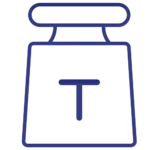Textile waste and disposal
Textile manufacturing, especially clothes production, is increasing every year. A growing issue of recycling and hazardous materials is causing headaches for waste management strategies.
In this guide, we address common waste streams, minimisation strategies and why the problem of textile recycling needs to be resolved.
We cover the following subjects in detail:
Textile manufacturing and waste streams
Waste minimisation in the textiles sector
Sustainable waste practices in the clothing industry
Why are textiles difficult to recycle?
WRAPs initiative: Textiles 2030
Textile manufacturing waste streams
Explore common textile waste streams, ranging from surplus packaging materials to dyeing chemicals. Each type of textile waste demands specific management and commercial waste collection strategies.
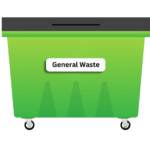
General waste
General waste in textile manufacturing includes discarded machinery parts, contaminated packaging, and office waste like non-recyclable paper and plastics. This arises from disposing of old equipment, processing raw materials and products, and everyday office activities.
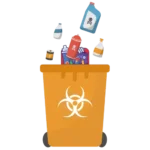
Hazardous waste
Hazardous waste, posing health or environmental risks, needs careful disposal.
In textiles, this includes toxic, flammable, or corrosive spent dyes, inks, solvents, and heavy metals from dyeing, machinery cleaning, and finishing processes. Managing these waste types is vital for preventing contamination and ensuring worker safety.
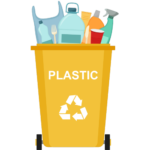
Plastic waste
Plastic waste mainly comes from packaging, synthetic fibres, and accessories, including shipping wraps, polyester scraps, and items like buttons and zippers.
Plastic waste is created as materials are unpacked, and unusable plastic elements are discarded. Recycling these plastics is crucial for reducing the environmental impact of waste.
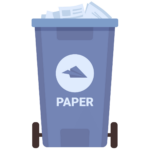
Paper waste
Paper waste mainly results from cardboard shipping boxes, basic office paperwork, and drafting sheets for patterns and layouts. It also arises from raw material delivery and design stages.
Recycling or repurposing this paper waste is key to reducing environmental impact and boosting sustainability.
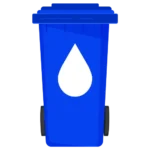
Water waste
Large quantities of water used in dyeing and treating fabrics become contaminated and are considered waste unless treated and recycled. The industry uses 93 billion cubic metres of water each year.
💡 Did you know
Every year in the UK, approximately 350,000 tonnes of used clothing, valued at around £140 million, are discarded into landfills. This means that over 30% of our unwanted garments are landfilled.
Waste minimisation strategies in the textiles industry
Waste minimisation in the clothing industry is vital as textiles are a difficult-to-recycle waste stream.
Here are five ways to minimise textile waste:
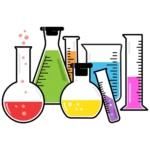
Chemical management systems
Reduce hazardous waste by using a chemical management system. This involves selecting less harmful chemicals, controlling storage, reducing the quantities used, and recycling wherever possible.
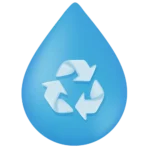
Water recycling systems
Install water recycling systems in dyeing and finishing processes to treat and reuse water, significantly reducing water consumption and pollution.
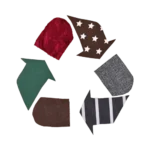
Fabric scrap upcycling programs
Develop in-house programs or form partnerships with other companies to collect and repurpose fabric scraps into new products, such as accessories, quilts, or even filling material for upholstery.

On-demand Manufacturing
Shift towards a make-to-order model to align production closely with demand, minimising overproduction and unsold goods. This approach reduces the waste associated with excess inventory and allows for more precise planning of material usage.

Lean manufacturing practices
Implement lean manufacturing principles to streamline production processes, reduce excess inventory, and minimise waste through continuous improvement practices.
Why are textiles difficult to recycle?
One of the biggest flaws in the textile industry is the fact clothing is incredibly difficult to recycle.
Textile recycling costs are prohibitively expensive, and commercial textile recycling options in the UK are limited. Most clothing waste in the UK is at an energy recovery facility or landfill.
Here’s a summary of the reasons that recycling textiles is prohibitively expensive:
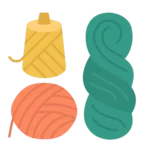
Components
The complexity of mixed fibre compositions in textiles presents a significant challenge for recycling. Garments often combine natural and synthetic fibres to enhance functionality, durability, or aesthetic appeal.
This mix complicates the recycling process, as different fibres require distinct recycling technologies. Separating these blended fibres to recover pure materials is technically challenging and cost-intensive, reducing recycling efficiency and effectiveness for such textiles.

Quality degradation through recycling processes
Textile recycling can lead to a diminution in fibre quality, especially after multiple cycles.
Each recycling process can shorten and weaken fibres, such as cotton, making them less suitable for new, high-quality textiles. Synthetics also degrade, affecting their resilience and aesthetics.
This decline in quality constrains using recycled materials in premium textile manufacturing.

The presence of dyes and finishes
Dyes and finishes are chemical treatments used in textiles to enhance colour, durability and performance.
However, as these chemicals become embedded within the fabric, separating and purifying the fibres for recycling is difficult. The various chemicals used across different textiles necessitate specific, often complex, processing to remove them without damaging the fibres.

Wear and tear on used textiles
The condition of used textiles significantly impacts their recyclability. Regular wear and tear can weaken fibres, cause damage, and introduce stains.
This makes reclaiming materials in a state suitable for high-quality recycling is challenging.
The deterioration limits the potential for these textiles to be processed into new products without extensive repair or treatment, which can be both resource-intensive and economically unfeasible.
Reformation and their transformational sustainable waste practices
Reformation, originally a vintage clothing store, expanded to focus on sustainable clothing, primarily premium dresses made out of recycled material.
They place a high priority on the environmental and safety aspects of their textile dyeing processes.
To ensure their products are free from hazardous substances and comply with regulations, they meticulously test all their items against restricted and banned substances.
💡 for more information on this, visit the Restricted Substance List (RSL) and the industry standards list AFIRM Group.
This extends to their choice of dye houses and printers, prioritising partnerships with facilities with certifications for eco-friendly and safe dyeing methods.
Reformation’s commitment to sustainability is shown through its use of the BLUESIGN® system for dyeing and the OEKO-TEX® Standard 100:
- BLUESIGN®: is recognised for its comprehensive approach to minimising environmental impact in the textile industry, ensuring that only safe input chemicals are used while monitoring air and water emissions and guaranteeing worker safety.
- OEKO-TEX® Standard 100: is a rigorous global standard that scrutinises textiles for the presence of harmful chemicals.
This alignment underscores Reformation’s commitment to producing safe, environmentally friendly products that protect consumers and the planet.
WRAPs initiative: Textiles 2030
Textiles 2030 is at the vanguard of revolutionising the UK’s fashion and textiles sector, advocating for a transition to sustainable and circular practices. It seeks to rally businesses and organisations around significant environmental goals by the end of the decade.
This initiative responds to the urgent need to mitigate the considerable environmental impact of the fashion and textiles industry.
Recognising that achieving sustainability is a collective endeavour, Textiles 2030 adopts a collaborative stance in addressing the climate crisis. It brings together vital players along the fashion and textiles supply chain by developing circular solutions.
Textiles 2030’s mission extends beyond mere ambition; it focuses on achieving specific, measurable outcomes committing to;
- A 50% cut in carbon footprint, and
- A 30% reduction in the water footprint of new textiles by 2030.
This dedication to measurable goals is underscored in annual reports that celebrate successes and honestly address persisting hurdles, underlining Textiles 2030’s dedication to industry-wide transformation for the welfare of society and the environment.
The rise of conscious consumerism
The rise of conscious consumerism significantly influences waste reduction in the UK clothing industry by shifting consumer behaviour and industry practices.
Massively influenced by the prevalence of second-hand clothing marketplaces (Vinted, Depop and ByRotation).
💡The UK is the largest consumer of second-hand clothing in Europe, with the market valued at £654 million in 2020.
Here are several ways this shift is making an impact:
- Consumers want eco-friendly products, so brands focus on using sustainable materials and reducing waste.
- People buy second-hand clothes more, which means less waste and fewer new clothes made.
- Brands are finding ways to turn old clothes into new ones because shoppers like recycled products.
- People buy fewer clothes but choose better quality ones, so they don’t throw away as much.
- Consumers want brands to be honest about where they manufacture and how they handle waste.
- Laws are changing because people want less waste, so governments are making rules to help.
Conscious consumerism drives the textiles and clothing industry towards sustainability, significantly contributing to waste reduction and environmental conservation.
However, the issue of fast fashion still persists;
Fast fashion contributes to volume and variety
A social issue – the fast fashion industry exacerbates the recycling challenge by significantly increasing the volume and variety of textiles produced.
Driven by consumer demand for constantly changing styles at low prices, this results in a rapid turnover of clothing. The sheer quantity of textiles, diverse materials, and short lifespans overwhelm existing recycling infrastructure and complicate sorting and processing efforts.
💡This poses a considerable social issue, encouraging a throwaway culture and increasing textile waste.


